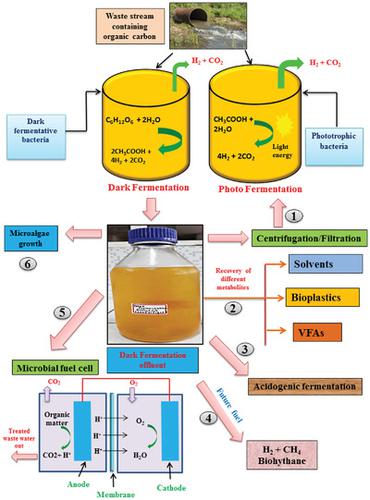当前位置:
X-MOL 学术
›
Biotechnol. Appl. Bioc.
›
论文详情
Our official English website, www.x-mol.net, welcomes your
feedback! (Note: you will need to create a separate account there.)
Development of novel strategies for higher fermentative biohydrogen recovery along with novel metabolites from organic wastes: The present state of the art
Biotechnology and Applied Biochemistry ( IF 3.2 ) Pub Date : 2020-05-31 , DOI: 10.1002/bab.1964 Raman Rao 1 , Nitai Basak 1
Biotechnology and Applied Biochemistry ( IF 3.2 ) Pub Date : 2020-05-31 , DOI: 10.1002/bab.1964 Raman Rao 1 , Nitai Basak 1
Affiliation

|
Depletion of fossil fuels and environmental concern has compelled us to search for alternative fuel. Hydrogen is considered as a dream fuel as it has high energy content (142 kJ g−1) and is not chemically bound to carbon. At present, fossil fuel–based methods for producing hydrogen require high-energy input, which makes the processes expensive. The major processes for biohydrogen production are biophotolysis, microbial electrolysis, dark fermentation, and photofermentation. Fermentative hydrogen production has the additional advantages of potentially using various waste streams from different industries as feedstock. Novel strategies to enhance the productivity of fermentative hydrogen production include optimization in pretreatment methods, integrated fermentation systems (sequential and combined fermentation), use of nanoparticles as additives, metabolic engineering of microorganisms, improving the light utilization efficiency, developing more efficient photobioreactors, etc. More focus has been given to produce biohydrogen in a biorefinery approach in which, along with hydrogen gas, other metabolites (ethanol, butyric acid, 1,3-propanediol, etc.) are also produced, which have direct/indirect industrial applications. In present review, various emerging technologies that highlight biohydrogen production methods as effective and sustainable methods on a large scale have been critically reviewed. The possible future developments are also outlined.
中文翻译:

开发用于更高发酵生物氢回收的新策略以及来自有机废物的新代谢物:目前的技术水平
化石燃料的枯竭和环境问题迫使我们寻找替代燃料。氢被认为是理想的燃料,因为它具有高能量含量(142 kJ g -1) 并且不与碳化学结合。目前,基于化石燃料的制氢方法需要高能量输入,这使得该过程成本高昂。生物制氢的主要过程是生物光解、微生物电解、暗发酵和光发酵。发酵氢生产具有潜在使用来自不同行业的各种废物流作为原料的额外优势。提高发酵制氢生产率的新策略包括优化预处理方法、集成发酵系统(顺序和组合发酵)、使用纳米颗粒作为添加剂、微生物代谢工程、提高光利用效率、开发更高效的光生物反应器等。更多的重点是在生物炼制方法中生产生物氢,在这种方法中,除氢气外,还生产其他代谢物(乙醇、丁酸、1,3-丙二醇等),具有直接/间接的工业应用。在本次审查中,对强调生物制氢方法作为大规模有效和可持续方法的各种新兴技术进行了批判性审查。还概述了未来可能的发展。
更新日期:2020-05-31
中文翻译:

开发用于更高发酵生物氢回收的新策略以及来自有机废物的新代谢物:目前的技术水平
化石燃料的枯竭和环境问题迫使我们寻找替代燃料。氢被认为是理想的燃料,因为它具有高能量含量(142 kJ g -1) 并且不与碳化学结合。目前,基于化石燃料的制氢方法需要高能量输入,这使得该过程成本高昂。生物制氢的主要过程是生物光解、微生物电解、暗发酵和光发酵。发酵氢生产具有潜在使用来自不同行业的各种废物流作为原料的额外优势。提高发酵制氢生产率的新策略包括优化预处理方法、集成发酵系统(顺序和组合发酵)、使用纳米颗粒作为添加剂、微生物代谢工程、提高光利用效率、开发更高效的光生物反应器等。更多的重点是在生物炼制方法中生产生物氢,在这种方法中,除氢气外,还生产其他代谢物(乙醇、丁酸、1,3-丙二醇等),具有直接/间接的工业应用。在本次审查中,对强调生物制氢方法作为大规模有效和可持续方法的各种新兴技术进行了批判性审查。还概述了未来可能的发展。











































 京公网安备 11010802027423号
京公网安备 11010802027423号